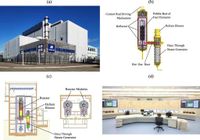In a significant leap for nuclear power technology, the high-temperature gas-cooled reactor pebble-bed module (HTR-PM) nuclear plant has successfully demonstrated its inherent safety features through extensive testing. This cutting-edge facility, which consists of two 200 MWt reactors, has been operating commercially in Shandong, China, since December 6, 2023, marking a pivotal milestone in the evolution of nuclear energy.
This groundbreaking achievement comes in the wake of safety concerns that have long plagued the nuclear industry, especially since the catastrophic accidents at Three Mile Island, Chernobyl, and Fukushima. Designed to be inherently safe, the HTR-PM utilizes natural physical and chemical principles to ensure safety, reducing the need for human intervention or mechanical devices. The essence of this design is to provide a robust and secure energy solution capable of meeting substantial energy demands while also playing a critical role in the fight against climate change.
Recent tests conducted between August 23 and September 1, 2023, showcased the reactor's capabilities during simulated loss-of-cooling scenarios, revealing that residual heat from the reactor could dissipate naturally—a fundamental aspect of its safety design. The tests verified for the first time the presence of inherent nuclear safety at a commercial power level of 200 MWt.
As a part of their operational protocol, the HTR-PM reactors employ a sophisticated coordinated control system to regulate their performance. This system enables the reactors to operate in tandem efficiently, sharing a common steam generator to maximize energy output. During tests, power levels were precisely managed, demonstrating the plant's ability to maintain stable operations during power ramping scenarios. On September 13, 2023, a power ramping test involved decreasing thermal power settings to 175 MWt and then gradually ramping back to 200 MWt, showcasing an impressive control response with minimal overshoot in power output.
The coordinated control system was rigorously tested further on September 15 when a turbine trip simulation prompted the emergency shutdown of one reactor while continuing to supply power from the second module. This incident illustrated the reactor's ability to handle unexpected operational challenges while maintaining stability across the system.
The innovation behind the HTR-PM design focuses on the multi-modular approach, where multiple small modular reactors (SMRs) operate collectively to deliver substantial power outputs. Unlike traditional designs, which utilize a single reactor for power generation, the multi-modular configuration enhances safety and efficiency by allowing shared resources and reducing dependency on single reactor systems.
This model not only offers economic advantages—by decreasing fuel inventory per module—but also significantly improves overall safety and scalability in nuclear plant design. As nuclear technologies evolve, the HTR-PM serves as a forefront example of how developments can respond to global energy demands while addressing safety concerns.
According to the authors of the article, “The verified multi-modular scheme is suitable for all those SMRs generating superheated steam,” which underlines the adaptability of this approach for future reactor designs. The ongoing validation of the HTR-PM's capabilities promises a transformative impact on how large-scale nuclear power plants may be constructed and operated moving forward.
Looking to the future, the HTR-PM project is already laying the groundwork for even larger installations, targeting plants like the 600 MWe multi-modular high temperature gas-cooled reactor known as HTR-PM600. This next step represents a significant stride towards creating competitive industrial heat sources and contributing to the decarbonization of various sectors.
As the commercial energy landscape shifts, inherently safe nuclear reactors such as the HTR-PM stand at the forefront of renewable energy initiatives. Their ability to deliver efficient and reliable power while adhering to strict safety standards could well define the role of nuclear technology in the global energy transition over the coming decades.




